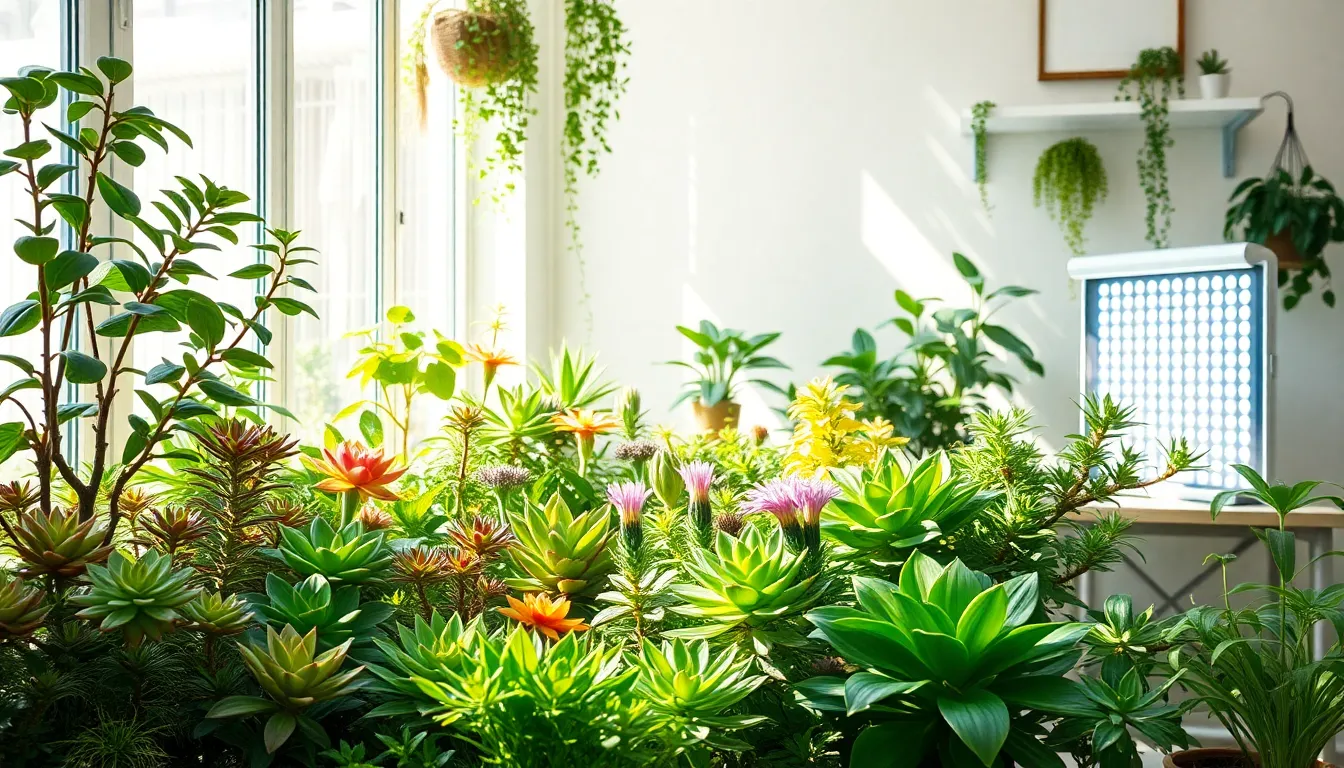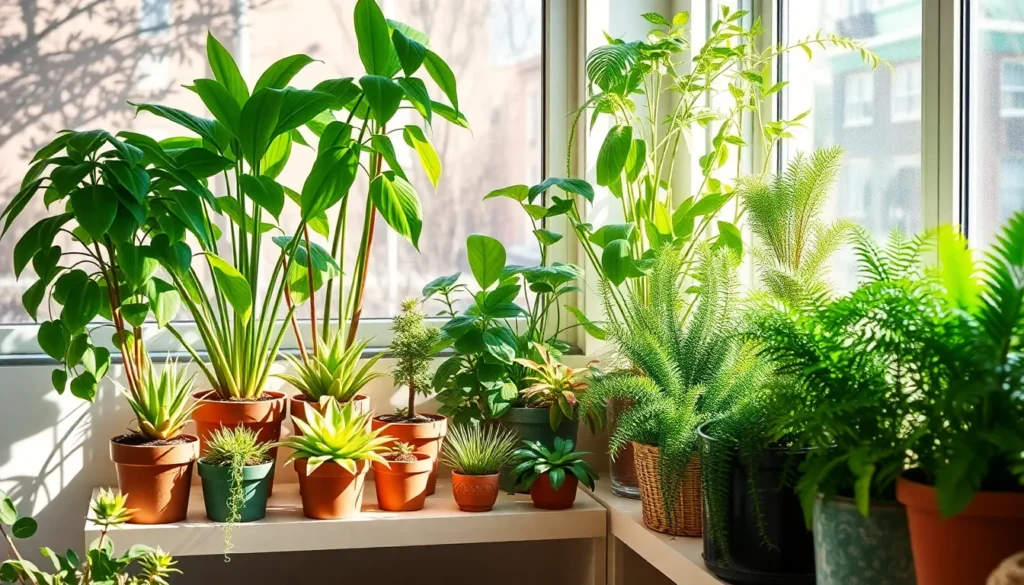Plants are like that friend who can’t decide what to wear—too much light and they’re sunburnt, too little and they’re sulking in the corner. Understanding plant lighting needs is essential for anyone looking to cultivate a thriving indoor garden. Whether it’s a sun-loving succulent or a shade-tolerant fern, each plant has its own unique preferences that can make or break its happiness.
Table of Contents
ToggleUnderstanding Plant Lighting Needs
Plants rely on light for photosynthesis, which fuels their growth and health. Understanding their specific lighting needs ensures thriving indoor gardens.
Importance of Light for Plants
Light plays a crucial role in plant growth. Insufficient light stunts growth and leads to weak plants, while excessive light can cause leaf scorching. Each plant species requires a specific light intensity and duration for optimal development. For instance, succulents thrive in bright, direct light, whereas ferns prefer lower-light conditions. Inadequate light affects not just growth but also flower production and overall vitality. Providing the right light levels is essential for achieving healthy, vibrant plants.
Types of Light Required
Different plants need varying types of light. Sunlight includes direct, indirect, and filtered light. Some plants, like cacti, benefit from full sun exposure. Others, such as pothos, thrive in indirect light. Artificial lighting options, including LED and fluorescent grow lights, mimic natural sunlight and support plant growth indoors. Grow lights should provide both blue light, which supports vegetative growth, and red light, which encourages flowering. Understanding these light types ensures optimal plant well-being and can lead to more robust indoor gardens.
Natural Light vs. Artificial Light

Natural light plays a vital role in plant health, mimicking the conditions found in outdoor environments. It provides a spectrum of wavelengths essential for photosynthesis, enabling vibrant growth and robust foliage.
Benefits of Natural Light
Natural light improves plant growth by offering a full spectrum, including ultraviolet, visible, and infrared light. Plants thrive under sunlight, promoting stronger photosynthesis and healthy maturation. Increased exposure supports the development of flowers, fruits, and leaves, ensuring a thriving indoor garden. Natural light requires no additional energy source, reducing electricity costs significantly. Species such as succulents and flowering plants flourish particularly well in these conditions. Sustainable practices emerge through reliance on sunlight, creating an eco-friendlier living space.
When to Use Artificial Light
Artificial light becomes essential when natural sunlight is insufficient, particularly during winter months or in low-light conditions. Grow lights, such as LEDs and fluorescents, can deliver targeted wavelengths tailored to specific plant needs. These lights enable gardeners to create optimal growing conditions regardless of seasonal changes. Short photoperiods in specific plant species benefit from managing light durations and intensities. Understanding individual plant requirements and matching them with appropriate light types ensures successful growth. Utilizing artificial light expands options for plant selection, making indoor gardening feasible and rewarding.
Light Duration and Intensity
Understanding the appropriate light duration and intensity is essential for plant health. Different plants require varying amounts of light exposure for optimal growth.
How Long Should Plants Be Exposed to Light?
Most plants thrive with 12 to 16 hours of light daily. Tropical species, like orchids, favor longer exposure, while succulents may require slightly less. During the winter months, plants can adapt to shorter days with around 10 to 14 hours of light. Growth stages influence light needs too; seedlings often require more light compared to mature plants. Observing plant response can help gardeners adjust light schedules effectively.
Measuring Light Intensity
Light intensity measurement is crucial for ensuring plant health. Lux and foot-candles are common units for measuring light intensity, with varying needs across plant types. Sun-loving species, such as tomatoes, flourish under 2,000 to 5,000 lux, while shade-loving species, like ferns, thrive in lower light, around 1,000 lux. Light meters, available from garden centers, assist in determining intensity levels. Adjusting light sources based on these measurements promotes better growth habits and vitality in plants.
Choosing the Right Grow Lights
Selecting the right grow lights plays a crucial role in indoor gardening success. Understanding the specific lighting needs of each plant ensures optimal growth and health.
Types of Grow Lights
LED grow lights offer energy efficiency and a customizable light spectrum suitable for various plants. Fluorescent grow lights typically provide a broader light spectrum, making them ideal for seedlings and smaller plants. High-Intensity Discharge (HID) lights, including Metal Halide (MH) and High-Pressure Sodium (HPS), produce strong illumination and are often used in larger setups. Incandescent lights, while less efficient, provide some benefit for plants in low-light conditions. Growers often select the type based on their plant species and desired growth outcomes.
Factors to Consider When Selecting Grow Lights
Light intensity remains a key consideration, as different plants require various levels for optimal growth. It’s essential to evaluate the area size and light distribution to ensure adequate coverage. Color temperature also matters; cooler temperatures support vegetative growth, while warmer colors promote flowering and fruiting. Energy consumption influences long-term costs; investing in energy-efficient options can reduce electricity bills. Knowing the lifespan of the lights can guide choices, as longer-lasting bulbs save replacement costs. Understanding these factors enables gardeners to make informed decisions, enhancing plant vitality and growth.
Understanding plant lighting needs is vital for thriving indoor gardens. By recognizing the specific light preferences of various species gardeners can create optimal conditions that promote growth and vitality. Balancing natural and artificial light sources allows for flexibility throughout the year.
Utilizing tools like light meters ensures that plants receive the correct intensity and duration of light. Selecting the right type of grow lights tailored to individual plant requirements further enhances success. With the right knowledge and resources gardeners can enjoy lush greenery and vibrant blooms in their homes.

